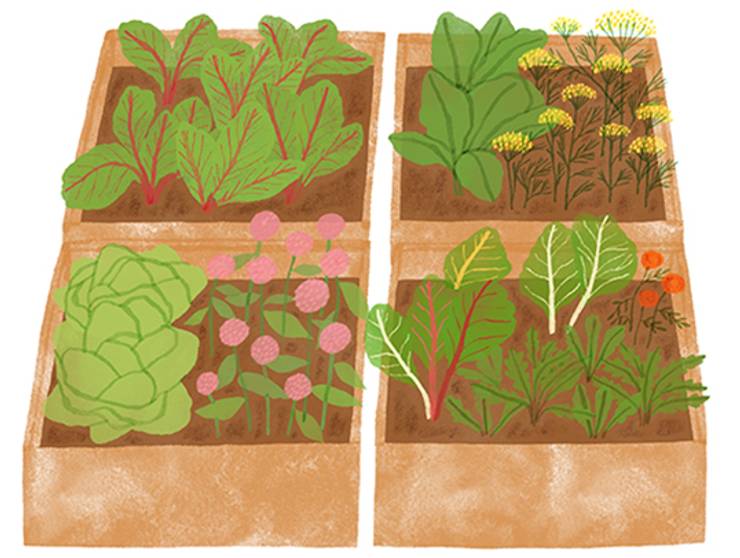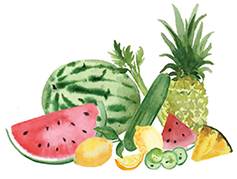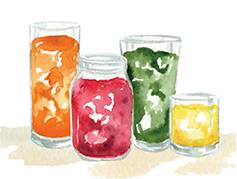Articles
How to Start a Vegetable Garden
One saying about gardening goes, “There are never mistakes, only experiments.”
Whether you are an experienced gardener or just someone who swoons at flowers and vegetables in your local community garden, developing your green thumb is a great way to expand your palate and cultivate a deeper relationship to the planet.
Inside every garden, large or small, are lessons about life and ways to understand the larger ecosystem.
The basics for all plants are the same whether they grow in a pot on a windowsill or directly in the ground. Becoming a gardener is all about understanding the fundamentals of light, water and soil. That’s it.
Of course, many people worry that they are not good with plants, but like any other skill, you can improve with time, and many health benefits might motivate you to get your hands a little dirty.
First, the act of gardening offers you access to more fresh veggies and fruit. You can find seeds or seedlings for varieties of vegetables that you might never see at the regular grocery store.

But beyond eating well, working in the garden—from digging in the dirt to watering and weeding—can also help strengthen your heart muscle and expand your lung capacity.
“There are physical benefits from doing the manual labor of gardening,” said UNC Health internal medicine physician Robert Hutchins, MD, MPH in an article. “It’s hard work to garden, and it provides some cardiovascular benefit.”1
Research has found that gardening can help reduce indicators of depression and anxiety.2
“Gardening gives you a chance to focus on something and put your mind to work with a goal and a task in mind,” Dr. Hutchins continued.
Spending time tending to a garden can make you feel happier. A 2020 study looked specifically at urban gardens and found that they helped boost happiness, especially vegetable gardens.3
Researchers surmise that part of that contentment comes from inhaling a healthy bacteria that lives in the soil called M. vaccae, which is known to help reduce anxiety and amplify levels of serotonin.4

Your Garden Glossary
Before we get into the steps of how to start the garden, let’s define some basic terms.
Plants fall into two general categories: annuals and perennials.
An annual is a plant that grows, flowers and produces seed all in one season and does not survive the winter, according to Proven Winner’s Dictionary of Garden Terms.5 Annuals must be planted each year. Examples include vegetables like cucumbers, kale, lettuce and carrots.
Meanwhile, a perennial is a plant that is cold hardy and will return again each spring, according to Proven Winner’s Dictionary of Garden Terms. Sometimes these plants will flower the first year, while others need more time to mature. Perennials also have different lifespans. Some will survive for many years while others may only live for a few years.
Examples of perennials include berry trees like blueberries or raspberries, herbs like chives and mint, along with flowers like asters, peonies and daylilies.
Another important garden term to understand is exposure, a term that refers to the optimum time the plant needs sun or shade to thrive and grow.
Full sun plants need six to eight hours or more of direct sunlight each day, while partial sun or partial shade means the plants need about four to six hours of sunlight.
Full shade refers to plants that require less than four hours of direct sun per day.
Finally, it’s important to know your hardiness zone. These zones are used to determine which plants are most likely to thrive at certain locations and are based on the lowest average temperatures an area experiences during the winter.
You can find your zone (in the United States) by typing your zip code into the USDA Plant Hardiness Zone Map.6
Gardeners can keep their zone in mind when selecting plants. Ideally, you want to pick the right plants for your zone.

Begin With a Plan
All good garden projects start with a little prep work. You’ll want to get clear on a few basics.
Do you have a spot to garden in? Again, this can be your backyard, a porch or a windowsill. Get clear on what you have space for in your home.
Pick your containers. Lots of veggies do great in containers so don’t be afraid to experiment. Most vegetables need about 12 inches of soil to thrive, and larger vegetables will require more space. Look for a 5-gallon container with a good drainage hole to start. A smaller container can work too if you are growing shallow-rooted plants like lettuce or herbs.
If you have a little more space in a front or back yard, raised garden beds are a great option that allow you to grow more vegetables in a limited space. Plus, you can control your soil quality.
Another important factor of planning your garden is getting to know the light. Most vegetables need full sun exposure. The best way to measure sunlight is to observe it for a week or two, check to see how much light is in your planting area in the morning, afternoon and early evening. This step is true for both indoor and outdoor setups.
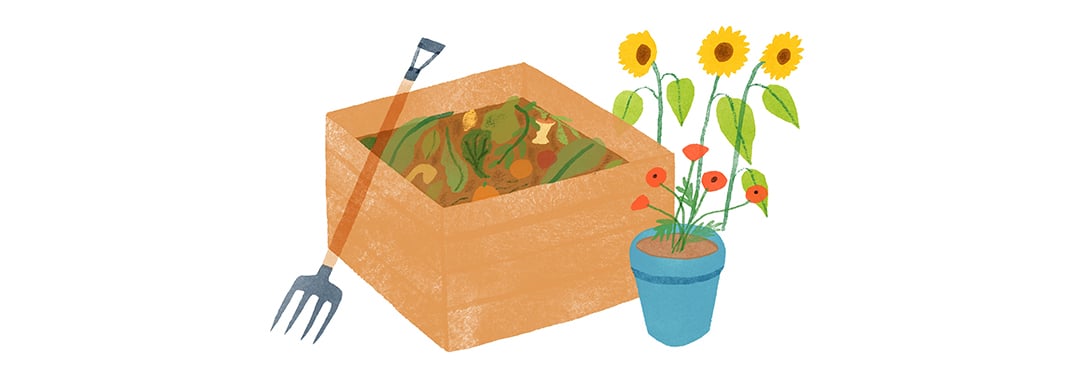
Soil Starters
Next you want to think about your growing conditions. Your plants thrive in part thanks to nutrients from the soil and most need a moist soil that drains well. If you are starting with a container garden, you can find a potting soil or mix at a garden or hardware store. These bags will have a mixture of materials such as peat moss, perlite, vermiculite, grit and/or compost.
For those working in the yard, you may need to amend your soil, especially if your soil has more sand or clay content. Amending it means adding organic matter, such as compost or fertilizer. Minerals like calcium and magnesium can really help vegetables flourish.
You can perform a soil test to see if you need to adjust the soil pH or add fertilizer before planting. You can order one online, buy it from a hardware store or check to see if your local Cooperative Extension service offers free tests.
PS: If you have leftover juice pulp, it can be a great addition to any compost pile. Learn more about composting here.

Tools for Growing
Next up is tools. You may want to get some garden gloves and a good shovel. Many local libraries rent more than just books so check out your branch to see if they rent garden tools or maintain a seed library. Or ask a neighbor if they have a few tools you can borrow.
Don’t forget about water. Do you have a garden hose in the backyard or a watering can to moisten the soil for your plants? Make sure you have a reliable way to water your plants.
You might be wondering how much or how little to water the garden. Vegetable gardens need about 1 inch of water per week. For a 100-square foot area, that’s about 62 gallons of water.
It can be hard to measure your water exactly. For example, if your garden is outside, plants might get drenched when it rains. One way to know if your plants need water is to check the soil. If it looks dry, you need to water your plants. If leaves are wilting, that’s another sign that your plants are thirsty.
In general, watering early in the day is a best practice, but obviously water whenever the garden looks like it needs it. On hot summer days, plants in containers or in the ground, will most likely need water every day.
Finally, check in on your hardiness zone to see what types of vegetables will do best in your location. Make a list of what you’d like to grow, and don’t forget to check in with others in your household to see what they might enjoy.

What to Grow for a Green Juice Garden
If you’re brand new to gardening, your best bet is to choose starter plants from a garden store or farmers’ market. These ready-to-plant seedlings, also called transplants, are essentially ready to go into the ground or a container. They have been nurtured through the early, delicate stages of growth by a professional.
For those who have a few seasons of gardening under their belt, you can start your garden from seeds indoors. Seeds are an inexpensive option, and you might find interesting varieties of vegetables. For more tips on starting from seeds, check out these tips from the University of New Hampshire.
If you want to create a “green juice garden” here are a few steps that will get you started:
1. Greens: Consider planting greens like kale, arugula, spinach, zucchini or cucumbers. Hot tip: vining cucumbers will grow upward, which is perfect for those in smaller spaces.
2. Root Vegetables: If you love root vegetable juices, you might try planting carrots, beets or radishes. These veggies are easy to grow and fit in small spaces. They do great in both containers and raised garden beds, so don’t be intimidated.
3. Tomatoes: Nothing says summer like fresh tomatoes. If you have a small space, consider smaller varieties like cherry, pear or grape tomatoes, which offer a sweet flavor and are great for snacking or adding to juices and salads. They grow a little faster than larger varieties too.
4. Herbs for Juice and Teas: Small space dwellers can also stick with herbs like basil, parsley and mint, which will all bring delicious flavor and nutrition to juices and more. Lettuces also do great in containers and give easy access to leaves when you want to make a salad.
If you want to make your own tea, you can grow herbs for that. Consider fragrant varieties like lavender, bee balm or chamomile. Holy basil, also called tulsi, makes a great tea or try some citrus flavors like lemon verbena or lemon balm. To brew your teas, just chop leaves and flowers from your herbs and let them steep in hot water for about 10 to 15 minutes. Use a strainer and remove the herbs before you enjoy your drink. For a refreshing treat, combine a fruit-forward juice and herbal tea over ice.
Final Thoughts
Now that you know the basics, are you excited to start a garden this year? It’s possible to cultivate a garden wherever you live, so get your plan together and get growing.
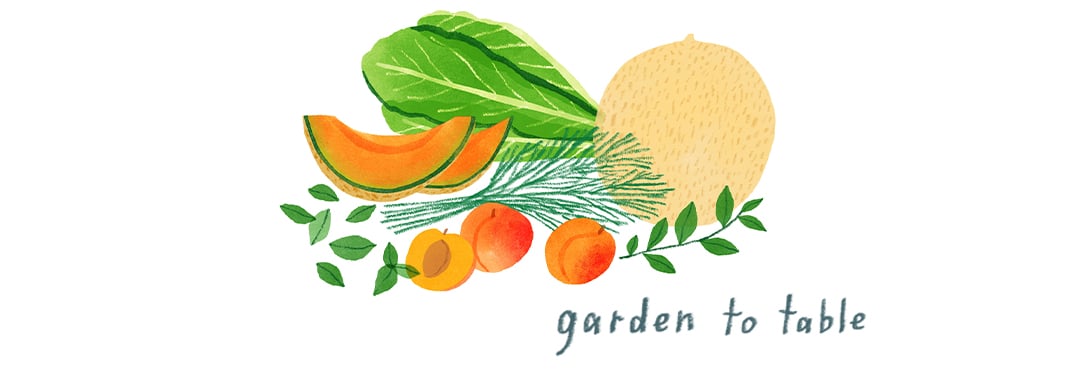
Our Favorite Produce Available in May
Here’s our guide to some of the best seasonal fruits and vegetables this month. Remember: seasonal foods will vary depending on where you live, soil conditions and weather.
BEST FRUITS & VEGETABLES IN SEASON

APRICOT
This round, yellow stone fruit comes into season in May and stays available throughout the summer. Apricots are naturally sweet with just a hint of tanginess. They are loaded with micronutrients including vitamins A, C and E, as well as dietary fiber and potassium.7 Like other stone fruits, you’ll want to pit it before adding it to your juicer. It pairs great with citrus or a high-yield fruit like pineapple.
• Shopping Tip: Look for fresh apricots with a bright golden color that are firm — but not too hard. Never buy them when they are soft, mushy, cracked, or bruised. And be sure to handle fresh apricots with care as they can bruise easily.
• Storage Tip: Store ripe apricots in the refrigerator for up to five days. (Reminder: The skin is edible!) You can also slice or cube apricot to be used in delicious dishes.

CANTALOUPE
Cantaloupe is also known as muskmelon, and originated in Persia. For centuries, this fruit has been highly valued as nutrient-rich and sweet-tasting. Cantaloupe season begins in May and runs through October. Fun nutrition fact: one study found that cantaloupe have the same amount of beta-carotene as carrots.8 They contain vitamins C, folate, fiber and potassium.9
• Shopping Tip: Shop for cantaloupe that look symmetrical, smell sweet and feel a bit heavy. The color should be a light yellow-orange with little to no green.
• Storage Tip: To enjoy the freshest flavor, store cantaloupe on the counter away from direct sunlight and eat within three days. You can also slice it up and put it in the fridge in an airtight container for about a week.

ROMAINE LETTUCE
Sometimes lettuce gets a bad rap for being mostly water, but romaine, also known as cos, is a bright, crispy green full of nutrition. It does have a slightly bitter flavor near the white bottom of the lettuce, so if you’re juicing it, adjust your recipe accordingly. Romaine is a powerhouse of minerals including calcium, magnesium and potassium along with vitamins A, C and K.10
• Shopping Tip: When choosing romaine at the store or farmers’ market, look for healthy, crisp leaves.
• Juicing Tip: Always wash this lettuce by rinsing any debris or dirt from the surface or soak the lettuce briefly in water to remove the dirt and then dry the leaves with a cloth or a salad spinner.
BEST HERBS IN SEASON
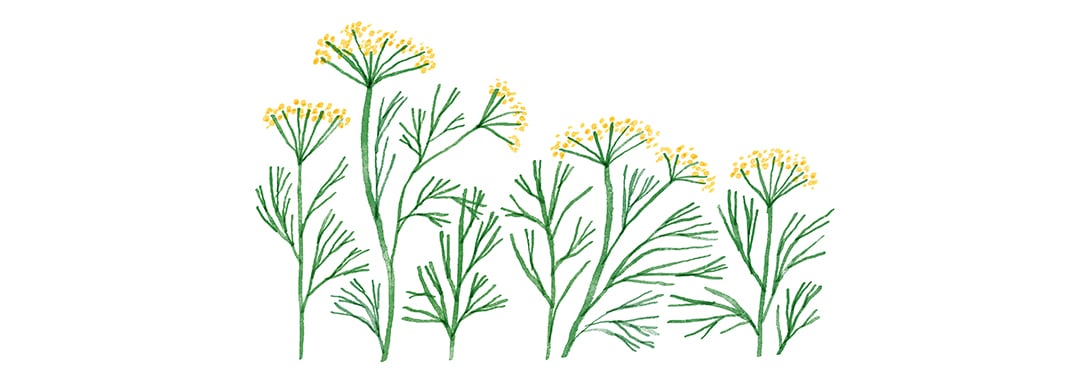
DILL
While dill is a popular herb used throughout the world, it has ancient roots. This aromatic, feathery herb that’s part of the carrot family has been used in ayurvedic medicine for centuries, and dill seeds have been used to help heal everything from digestive issues to bad breath.11 But it doesn’t just bring the flavor, dill also contains essential nutrients like vitamin C, magnesium and vitamin A.12 Dill is usually sold in large batches and its flavor goes a long way, so it’s a great herb to add to juices.
• Shopping Tip: Look for bright green feathery fronds without any wilting or brown spots.
• Storage Tip: The best way to store dill is to wrap it in a paper towel and put it in the crisper drawer of your refrigerator. It also freezes well. You can chop it up and add it to ice cube trays with water and just thaw them when you want to use your dill.
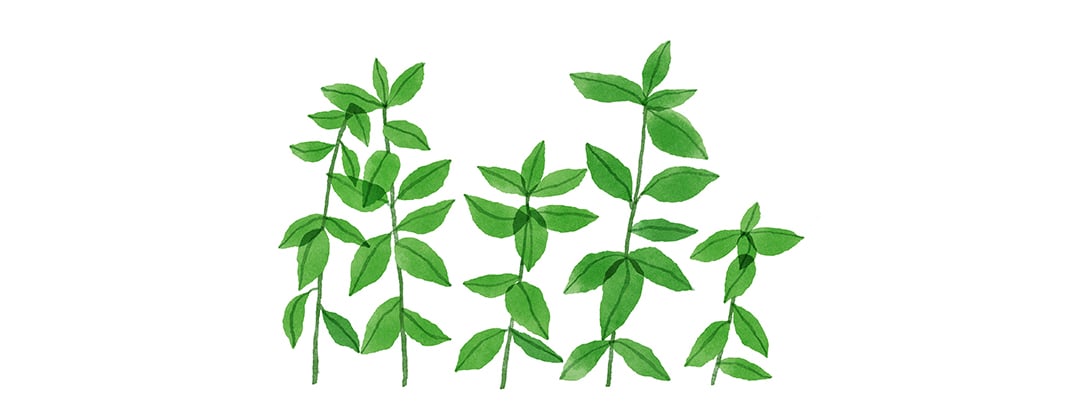
MINT
Mint is another fragrant herb that might remind you of your favorite ice cream flavor or toothpaste. Traditionally, it’s been used to help freshen breath and also help relieve stomach issues as it’s known to help calm the muscles of the digestive tract. Healthwise, mint contains a decent amount of vitamin A, folate and potassium.13
• Shopping Tip: Look for perky leaves that are even-colored, not wilting. Don’t forget to use your nose, fresh mint should give off its signature scent.
• Storage Tip: Mint is another herb that you can wrap in a paper towel or clean cloth and put it in the crisper drawer of your refrigerator.
• Varieties: Hundreds of types of mint exist but some of the most common varieties you’ll find include spearmint, peppermint, chocolate mint, pineapple mint, apple mint and Swiss mint.
COMMUNITY MEMBER SPOTLIGHT

Juicing Tips
from Tyrone Cherry
1. What is your favorite produce to juice from your garden?
One of the things I love growing and juicing are carrots. They are super simple to grow. They can grow in most seasons, even over winter, which makes them sweeter in the spring, and they go well in almost any juice. The act of sowing carrot seeds is also a practice in mindfulness for me.
2. What is your favorite juicing tip?
Grow what you enjoy eating…don’t be intimidated by all the options of seed packets and transplants in the store. Start with growing things that you enjoy eating. It will help you develop a more intimate relationship with your food as well as help you save some money at the grocery store.
• You gotta sow to grow…the first step to growing is sowing a seed. Don’t get overwhelmed by all the different methods of growing food, simply sow a seed and enjoy the experience of watching it grow.
• Share your growth…connect with others in your commUNITY who are growing and/or start your own commUNITY of growers. Share your struggles and successes. One of the least talked about products of gardening is inspiration, that which you get from the garden and the encouragement it gives others to grow
Inspiring Nonprofit to Know About
Each month, we celebrate an inspiring nonprofit that makes fruits and vegetables more accessible to everyone.
The Edible Schoolyard Project
Founded in 1995 by chef, author and activist Alice Waters, The Edible Schoolyard Project is a nonprofit organization dedicated to the transformation of public education by using organic school gardens, kitchens, and cafeterias to teach both academic subjects and the values of nourishment, stewardship and community.
sources:
- https://healthtalk.unchealthcare.org/health-benefits-of-gardening
- https://www.sciencedirect.com/science/article/pii/S2211335516301401
- https://www.sciencedirect.com/science/article/pii/S0169204619307297?via%253Dihub
- https://www.discovermagazine.com/mind/is-dirt-the-new-prozac
- https://www.provenwinners.com/learn/dictionary-gardening-terms
- https://planthardiness.ars.usda.gov
- https://fdc.nal.usda.gov/fdc-app.html#/food-details/171697/nutrients
- https://www.ncbi.nlm.nih.gov/pmc/articles/PMC3544477
- https://fdc.nal.usda.gov/fdc-app.html#/food-details/169092/nutrients
- https://fdc.nal.usda.gov/fdc-app.html#/food-details/169247/nutrients
- https://www.ncbi.nlm.nih.gov/pmc/articles/PMC3249919
- https://fdc.nal.usda.gov/fdc-app.html#/food-details/172233/nutrients
- https://fdc.nal.usda.gov/fdc-app.html#/food-details/173474/nutrients
- Choosing a selection results in a full page refresh.
- Press the space key then arrow keys to make a selection.
